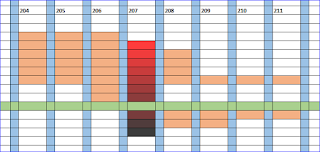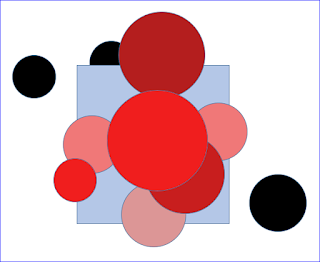I have posted before on frames and threads of consciousness - see references 1 and 2. Here I put an assembly spin on them.
I start with an illustration of a fragment of consciousness, a take in the film flavoured jargon I have introduced with descriptive experience sampling. Where frame 207 is made up of 7 threads of varying degrees of consciousness – red more conscious and black less conscious, with the waterline marked in green – with 3 unconscious threads in support. Perhaps they were conscious recently, will become conscious soon or are important for some other reason, remembering here that threads can have quite long and varied lives. Perhaps one of them is not quite conscious, carrying one of those very short, subliminal stimuli that psychologists and neurologists like to play with, especially now that they have got computers to make it easy for them, to flash the lights for them. An example which points up a worry about frame duration: the illustration allows for frames of various durations, but what about the duration of the cells within a frame?
By way of another example, my mother used to claim that she could track the four lines of a string quartet, so in her case one might have, inter alia, a thread for each of those four lines. The irritating person sitting next to her, turning the pages of his programme, might be another thread, might be popping into the edge of her consciousness from time to time. Organising lunch for the children the next day might be yet another.
Each of the cells in the column for frame 207 stands for an assembly of neurons, throbbing away, a clump which is possibly visible to the right sort of scanner. We suppose that this assembly is active in, what I think is called in the jargon, a meta-stable state. That is to say, the state persists for a short while, perhaps as long as a second, but is easily pushed off its perch to make way for the next one, in this case, frame 208. By the state persisting, we mean that the assembly of neurons and synapses is spiking in some more or less repetitive way. We suppose that the assembly is fixed for the duration, with the same population of neurons and synapses, the same synapse weights and the same anything else which goes to specify the assembly. Some models, for example, talk of synaptic delays as well as synaptic weights.
This repetitive pattern of synaptic activity and firing amounts to a cell of consciousness in the sense of the illustration above, with the proviso that one needs a reasonable number of repeats to generate the phenomenon of consciousness. Perhaps a dozen or more. Perhaps there is some frequency band within which those repeats need to lie, with the 40Hz of the gamma band of brain waves fitting well with the notion that consciousness comes in chunks of half a second or more.
We suppose that in the future we will be able to devise some test which could peer at an assembly from the outside and decide whether or not it amounted to a bit of consciousness – hopefully, sometimes, with the agreement with what the subject of that bit of consciousness thought about it. Perhaps something along the lines of the Bispectral Index contraption mentioned at reference 2. Perhaps something which would also tell us how it is that consciousness manages to emerge, to be visible, as it were, against what must be the huge amount of background clutter which is not visible. Will it turn out to be something much more complicated than just a bit of form, something loud and clear emerging from the background chaos, a log drifting about on the water foaming around it, chaos which might for these purposes be thought of as white noise? No doubt doing something important, but just noise when seen from this particular point of view?
We suppose also that the total amount of consciousness is limited in some sense, the blue square of consciousness in the illustration below, perhaps by the volume or intensity of the content, measured in some cunning statistical way, although it seems likely that people are going to vary in the amount of stuff that they can hold in consciousness. And in the case of most people, we would expect the various threads which are conscious to add up to a more or less coherent whole, perhaps adding up to some part of the complicated scene in which the person concerned found himself, while bearing in mind that some other people seem to be able to keep various quite different things on the go at once – noting in passing that these must be people for whom the act of hearing cannot activate the speech apparatus in the way it might for the rest of us, there being only one such apparatus. See references 3 and 4.
Note the dark matter, not available to consciousness, but perhaps available to a clever ECG or to a clever fMRI machine.
The whole operation needs to be enabled, to be fuelled – not exclusively in the sense of the energy needed to drive all this electrical and chemical activity – by more than ongoing sensory stimulation – which may not, after all, be what one is conscious of. We suppose that this fuel is pumped up, in some sense or other, from the upper brain stem. Knock out the upper brain stem and you knock out consciousness.
I close with a couple of comments on other material. First the dog’s life at reference 5, which does not really cut across the present story, despite appearances, rather it sets the current story in its biological setting. Also, there is more interest there in what it might be that drives the subjective experience of consciousness, rather than the information processing machinery in the background. Second, the integrated information theory (IIT, or Phi) at references 6, 7 and 8, a theory which is very much tramping around in my chosen ground. I started with the picture book at reference 8, but got a bit lost in reference 6 and even more lost in the mathematical version at reference 7. I ought to have another go, but my present take is that I am not convinced by IIT. In particular, I am not convinced by the integration bit, I do not believe that a moment of consciousness is integrated, whole and indivisible, in quite the way that Tononi and his colleagues would have it. I like my threads and go for a loose federation rather than a unification.
Reference 4: http://psmv3.blogspot.co.uk/2016/11/on-saying-cat.html.
Reference 5: http://psmv2.blogspot.co.uk/2015/08/its-dogs-life.html.
Reference 6: Consciousness: here, there and everywhere? - Giulio Tononi and Christof Koch – 2015.
Reference 7: From the Phenomenology to the Mechanisms of Consciousness: Integrated Information Theory 3.0 - Masafumi Oizumi, Larissa Albantakis, Giulio Tononi – 2014.
Reference 8: PHI: a voyage from the brain to the soul - Tononi – 2012.


No comments:
Post a Comment